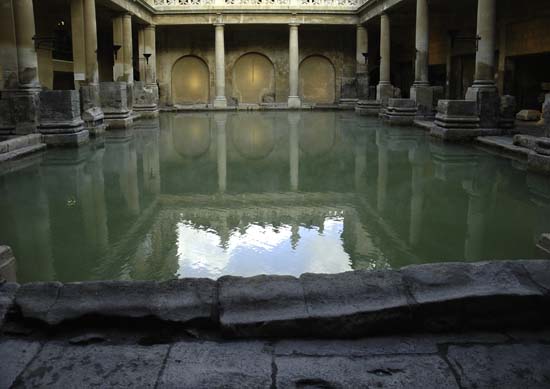
Bath houses were one of the most commonly used facilities of the Ancient Romans. These bath houses were taken very seriously by the Ancient Romans as many important things were discussed there. Bath houses were known as thermae or balneae. Thermae were usually the much larger imperial bath houses while balneae were the smaller bath houses that were in great numbers throughout Ancient Rome.
Washing and good hygiene was very important in Ancient Roman Society. Bathing was considered to be part of a Roman citizens daily routine. It was available to the rich and poor citizen. The Roman elite also had baths in their own villas. The bathing experience was not like that of today where one would have privacy. Bath houses were very social and allowed Romans to socialize, discuss politics, and do business. It was more like a modern day spa that allowed Ancient Roman citizens to exercise, socialize, and bathe.
There were more than 900 public baths houses throughout the Ancient Roman Empire. Most of the elaborate baths were located at the heart of the empire in Ancient Rome. The smaller bath houses had about 300 people attending them while the much larger ones had around 1,500 people. Bath houses were elaborately decorated with: lavish stones like marble, gardens, courtyards, shops, restaurants, galleries, libraries, and statues.
Most Romans did not have baths in their homes like modern times due to the cost associated with having one. In Ancient Rome, water was supplied to homes but it was taxed heavily by pipe size. Most Roman citizens only had a small water source for everyday use, but not for personal hygiene. Bath houses only allowed adults in and cost very little to attend. Men and women both attended the bath house but at different times. It should be noted that the women’s time at the bath house was not as long as the men’s time. Women were allowed in the early part of the day while the men usually went after work.
Types Of Baths
Taking a bath in Ancient Rome was very different than today. Roman Citizens were able to choose from three different baths. They were know as the caldarium which is a hot bath, tepidarium which is a warm bath, and frigidarium which is a very cold bath.
The frigidarium was a cold pool in the Ancient Roman Bath house complex where cold water was used to close the pores of the skin. These pools could range in size depending on the bath house. The Romans kept these pools cold by adding snow. This part of the Roman bath process was considered the last part of the bath and was meant to refresh the citizen before they left the bath house.
The tepidarium was a part of the bath house that had direct heat from the floors and the walls. This direct heat was used as a therapeutic bath. The tepidarium was the most popular part of the bath house. The tepidarium was usually the center point of most bath houses where Roman Citizens could choose to enter the frigidarium or the caldarium. The tepidarium was also the place where Ancient Romans used the strigil to clean themselves. A strigil was a small metal piece that was curved used to remove dirt and sweat. It was found in many different sizes to accommodate different body parts. It was done by applying a perfumed oil to the skin and then scraping off by the appropriate strigil. It should be noted that most people did this technique of bathing themselves however the rich used slaves.
The caldarium was a hot plunge pool in the bath house complex used to open the skin pores of Ancient Roman citizens. It was considered the hottest bath and was heated with an under floor heating system called a hypocaust. This was a room that was very hot and steamy made to encourage sweat. Most Roman citizens wore wooden sandals to prevent burning of the feet and used cold dishes of water to cool themselves down. It was believed temperatures were well over 100 degrees Fahrenheit with 100 percent humidity.

